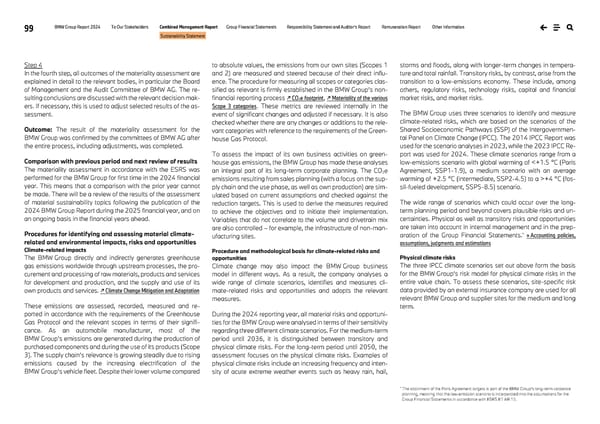99 BMW Group Report 2024 To Our Stakeholders Combined Management Report Group Financial Statements Responsibility Statement and Auditor’s Report Remuneration Report Other Information Sustainability Statement Step 4 In the fourth step, all outcomes of the materiality assessment are explained in detail to the relevant bodies, in particular the Board of Management and the Audit Committee of BMW AG. The re- sulting conclusions are discussed with the relevant decision mak- ers. If necessary, this is used to adjust selected results of the as- sessment. Outcome: The result of the materiality assessment for the BMW Group was confirmed by the committees of BMW AG after the entire process, including adjustments, was completed. Comparison with previous period and next review of results The materiality assessment in accordance with the ESRS was performed for the BMW Group for first time in the 2024 financial year. This means that a comparison with the prior year cannot be made. There will be a review of the results of the assessment of material sustainability topics following the publication of the 2024 BMW Group Report during the 2025 financial year, and on an ongoing basis in the financial years ahead. Procedures for identifying and assessing material climate- related and environmental impacts, risks and opportunities Climate-related impacts The BMW Group directly and indirectly generates greenhouse gas emissions worldwide through upstream processes, the pro- curement and processing of raw materials, products and services for development and production, and the supply and use of its own products and services. ↗ Climate Change Mitigation and Adaptation These emissions are assessed, recorded, measured and re- ported in accordance with the requirements of the Greenhouse Gas Protocol and the relevant scopes in terms of their signifi- cance. As an automobile manufacturer, most of the BMW Group’s emissions are generated during the production of purchased components and during the use of its products (Scope 3). The supply chain’s relevance is growing steadily due to rising emissions caused by the increasing electrification of the BMW Group’s vehicle fleet. Despite their lower volume compared to absolute values, the emissions from our own sites (Scopes 1 and 2) are measured and steered because of their direct influ- ence. The procedure for measuring all scopes or categories clas- sified as relevant is firmly established in the BMW Group’s non- financial reporting process ↗ CO2e footprint, ↗ Materiality of the various Scope 3 categories. These metrics are reviewed internally in the event of significant changes and adjusted if necessary. It is also checked whether there are any changes or additions to the rele- vant categories with reference to the requirements of the Green- house Gas Protocol. To assess the impact of its own business activities on green- house gas emissions, the BMW Group has made these analyses an integral part of its long-term corporate planning. The CO2e emissions resulting from sales planning (with a focus on the sup- ply chain and the use phase, as well as own production) are sim- ulated based on current assumptions and checked against the reduction targets. This is used to derive the measures required to achieve the objectives and to initiate their implementation. Variables that do not correlate to the volume and drivetrain mix are also controlled – for example, the infrastructure of non-man- ufacturing sites. Procedure and methodological basis for climate-related risks and opportunities Climate change may also impact the BMW Group business model in different ways. As a result, the company analyses a wide range of climate scenarios, identifies and measures cli- mate-related risks and opportunities and adopts the relevant measures. During the 2024 reporting year, all material risks and opportuni- ties for the BMW Group were analysed in terms of their sensitivity regarding three different climate scenarios. For the medium-term period until 2036, it is distinguished between transitory and physical climate risks. For the long-term period until 2050, the assessment focuses on the physical climate risks. Examples of physical climate risks include an increasing frequency and inten- sity of acute extreme weather events such as heavy rain, hail, storms and floods, along with longer-term changes in tempera- ture and total rainfall. Transitory risks, by contrast, arise from the transition to a low-emissions economy. These include, among others, regulatory risks, technology risks, capital and financial market risks, and market risks. The BMW Group uses three scenarios to identify and measure climate-related risks, which are based on the scenarios of the Shared Socioeconomic Pathways (SSP) of the Intergovernmen- tal Panel on Climate Change (IPCC). The 2014 IPCC Report was used for the scenario analyses in 2023, while the 2023 IPCC Re- port was used for 2024. These climate scenarios range from a low-emissions scenario with global warming of +4 °C (fos- sil-fueled development, SSP5-8.5) scenario. The wide range of scenarios which could occur over the long- term planning period and beyond covers plausible risks and un- certainties. Physical as well as transitory risks and opportunities are taken into account in internal management and in the prep- aration of the Group Financial Statements.* » Accounting policies, assumptions, judgments and estimations Physical climate risks The three IPCC climate scenarios set out above form the basis for the BMW Group’s risk model for physical climate risks in the entire value chain. To assess these scenarios, site-specific risk data provided by an external insurance company are used for all relevant BMW Group and supplier sites for the medium and long term. * The attainment of the Paris Agreement targets is part of the BMW Group’s long-term corporate planning, meaning that the low-emission scenario is incorporated into the assumptions for the Group Financial Statements in accordance with ESRS E1 AR 15.
 BMW Group Report 2024 Page 98 Page 100
BMW Group Report 2024 Page 98 Page 100